Private McAlpine’s Horse
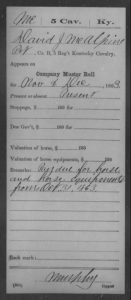 My own twice-great granddaddy 43-year-old David Jackson McAlpine left Jackson, Tennessee, in October 1861, for a $100 bounty. He probably needed the money. He and Miss Eliza Wells–married on Christmas Eve in 1839–had sixteen children at the time and one to be born in early 1862. With him went a horse. He and the horse joined the 5th Kentucky Cavalry, Company B, under Colonel David R. Haggard. Haggard felt he should organize the local Unionists as a measure of protection against the threat of Confederate forces in Tennessee.
My own twice-great granddaddy 43-year-old David Jackson McAlpine left Jackson, Tennessee, in October 1861, for a $100 bounty. He probably needed the money. He and Miss Eliza Wells–married on Christmas Eve in 1839–had sixteen children at the time and one to be born in early 1862. With him went a horse. He and the horse joined the 5th Kentucky Cavalry, Company B, under Colonel David R. Haggard. Haggard felt he should organize the local Unionists as a measure of protection against the threat of Confederate forces in Tennessee.
Wherever there was a McAlpine, there was sure to be a horse. Horses were a family passion. Granddaddy Mac listed his job in each census as “farmer,” but his heart was in breeding horses (and children). Family stories have come down that McAlpine bred a certain kind of horse–a combination of a Morgan and a Standardbred. It was said that a Morgan, an American-bred horse, could “pull a plow all day in the fields on Saturday, drive the family carriage to church on Sunday and carry its master to work on Monday.” Standardbreds, also an American breed, brought more height, strength, and flash to the Morgan line. Apparently, Granddaddy Mac liked flash in a horse. Nowadays, this kind of horse is referred to as a “heritage breed,” but I suspect they were just McAlpine pets. I cannot find the name of the one Granddaddy Mac brought with him, but this horse shows up in every company muster roll, “Pay due for horse and horse equipment since last paid,” until August 10, 1864. The image below is someone else, but neither this rider nor my ancestor has shoulder straps, and the horse looks as if he worked hard. Alas, my relatives took very few photographs.
The 5th Kentucky Cavalry was a hard-working group. It participated in every battle from Chickamauga to the siege of Atlanta, which included participation in Union Cavalry General Judson Kilpatrick’s Raid and other actions under “Kill Cavalry” from early July into August 1864. Kilpatrick did not kill my ancestor, but he may have killed the horse. All company muster rolls after this time no longer mention any horses related to Granddaddy Mac. On May 3, 1865, he and the rest of his pards mustered out and went home.
Everything would have been fine, except for a letter. It is from the Adjutant General’s Office in Washington, dated August 12, 1868. Granddaddy Mac hired a lawyer to help make a case for financial reimbursement for the loss of his horse. Apparently, he had been working on this project for a while, as the word “reconsideration” is used. The letter claims there was “no official record that he had a private horse in service,” or that he had ever received pay for one. So what are those company muster rolls talking about? A fake horse? The letter goes further, mentioning that the loss of this non-existent horse should have been reported to 5th KY officers as quickly as possible, so the officers could fill out the correct paperwork “in a timely manner.” The horse went missing during the Battle of Atlanta. My suspicion is that the officers were just a little busy then. The loss of one horse simply was not a priority for anyone except my relative, who was probably heartbroken.
Other ECW folks who have shared their personal family stories have been related to much more illustrious men than my twice-great grandfather. David Jackson McAlpine entered the Army as a private and left it as a private–and that seems to have been a problem for the Adjutant General’s office:
The practice of the office has been to reject all claims of enlisted men when there was no record evidence either of loss, muster-in, or services of the horses, for the following reasons:
… and then a list of “reasons” follows. Basically, no enlisted soldier had the means, will, or anything else to provide a horse of his own. Enlisted men were probably liars anyway, and horse thieves to boot:
It is also well-known that as the army moved through the enemies’ country horses were picked up and used by the soldiers, these were of course the property of the United States, and nothing ought to be paid for the use, risk, or loss of such a horse. There are, it is believed, many thousand cases of this kind.
No wonder the average Yankee sometimes growled!
This insulting letter ends with a refusal to reimburse Granddaddy Mac for the loss of his horse, reminding him that to believe the words of an enlisted man would “open the door to a large number of fraudulent claims.”
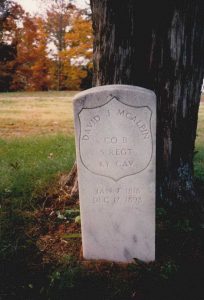 My great-great-grandfather, David Jackson McAlpine, never got his money. He could have used it since his family eventually grew to twenty children, but that is not the point, is it? David McAlpine was a Unionist living in a seceded state. He was old enough not to have to serve in the military, but he did anyway. Private McAlpine showed up for muster with his own horse, serving from October 1861 until May 3, 1865. But, apparently, McAlpine was not trustworthy enough to be reimbursed for a horse that died from either battle or years of hardship in the 5th Kentucky cavalry. Had it been Cincinnati, Baldy, or Rienzi who was the subject of the letter, the outcome would have been very different. I’m still miffed
My great-great-grandfather, David Jackson McAlpine, never got his money. He could have used it since his family eventually grew to twenty children, but that is not the point, is it? David McAlpine was a Unionist living in a seceded state. He was old enough not to have to serve in the military, but he did anyway. Private McAlpine showed up for muster with his own horse, serving from October 1861 until May 3, 1865. But, apparently, McAlpine was not trustworthy enough to be reimbursed for a horse that died from either battle or years of hardship in the 5th Kentucky cavalry. Had it been Cincinnati, Baldy, or Rienzi who was the subject of the letter, the outcome would have been very different. I’m still miffed
______________________________________________________________
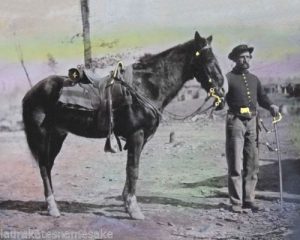
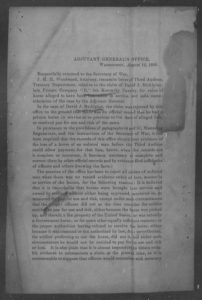

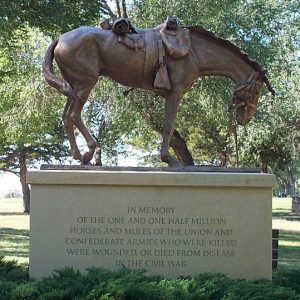
Absolutely love hearing new and interesting stories like this about non commissioned troops like your grandfather, the ones who truly fought and endured all the hardships soldiering had to offer. It’s frustrating that he never got his money too, what a slap in the face.
Finding this story was a real treat. Apparently Grandaddy Mac referred to his many children as “thoroughbred babies,” If I could, I’d send him the money!
The horses get lots of attention in the family stories. Apparently even when cars showed up the fam had horses.
Thanks Meg.
My wife’s Great Grandpa, Robert Terrell, rode his horse to Indianapolis to enlist in the 3rd Indiana Cavalry. He lost his horse at Cedar Creek. Then, spent the rest of the war in Libby prison.
Where is the horse monument?
This version of the monument is at Ft. Riley, KS. It marks the grave of Chief, the last cavalry mount in the army.
This particular version of the Horse & Mule monument is at Fort Riley, KS. It marks the grave of Chief, the last of the US Army cavalry horses.
This may be the monument to cavalry horses in front of the National Sporting Library and Museum in Middlburg, Va.
There are several versions of this statue, but this one is at Fort Riley, KS. It marks the grave of Chief, the last horse in the US Cavalry.
Brilliant tale very well told. But Meg do check the gender of your French quote.
Oh dear–I took it from the interwebs–mea culpa and “say lah vee!”
One of my confirmed ancestors was a private in the 15th Confederate Cavalry. His muster rolls mentions his horse a couple of times, but I know so little about his experience during the war. They didn’t do much of consequence down here in Florida and Alabama, though. I’ve got books on Morgan’s Raiders and Nathan Bedford Forrest’s operations, but is there a generic book about the life of a soldier in a cavalry unit?
My 2-great grandma’s brothers were in Co H of the 8th Missouri State Militia Cavalry (Union). One lost his horse in action August 5, 1864 and his muster-out shows he was paid $100 for it. I googled the value in modern dollars – about $1600.
Interesting article; If I had 16 kids I’d join the army too !
Maybe his wife sent him, hoping for a break.
He came home a couple of times during the war. He ended up with 20 children. They lost a few, but not many.
The Nichols were always horse poor ranchers in central Arizona. We never could bear to sell a horse. Ours descended from Steeldust, a famous race horse. They either had lined backs (which in addition to the line included a darker colored mane and tail than their hides). They were all tall and sturdy and good natured. They did have a well developed disposition, after a long day on the trail, of heading for the barn over the less than determined control efforts of a bunch of child cowboys/girls who liked the race. Dad didn’t much like the unnecessary danger at the end of a long day. “But she/he ran away with me” didn’t carry much weight.
My great grandfather also fought at Cedar Creek, same story & same grandfather. Paul, you must be the husband of my cousin , Cheryl. Jim Terrell Kuhlman